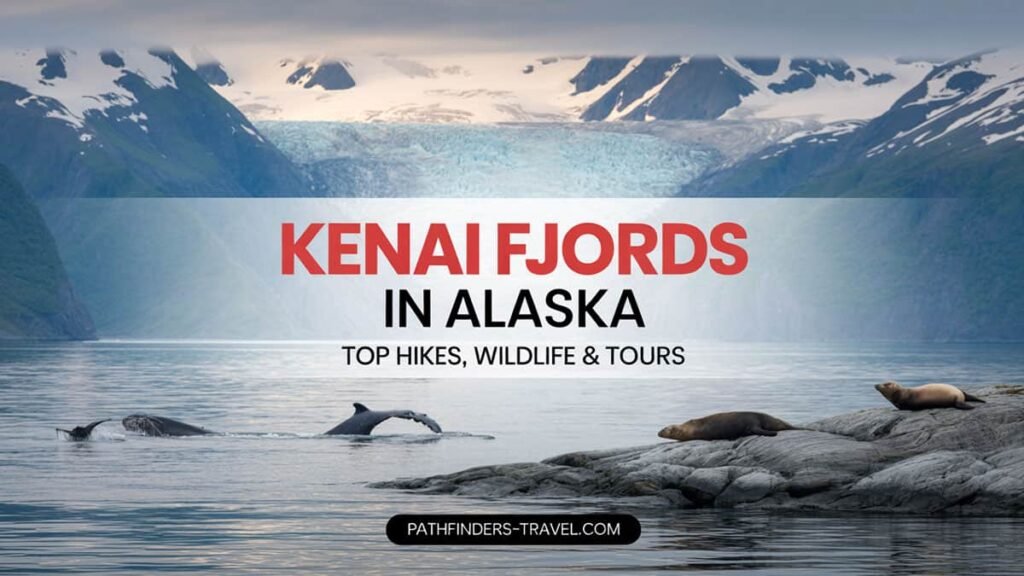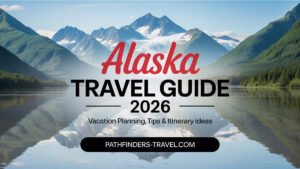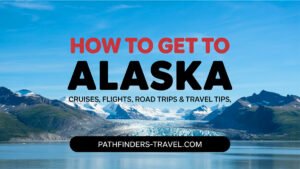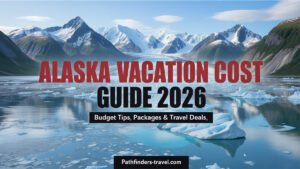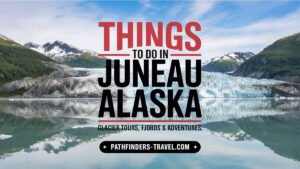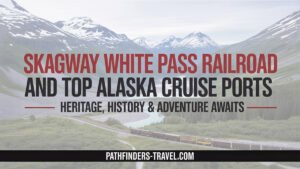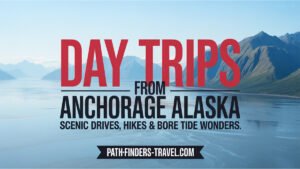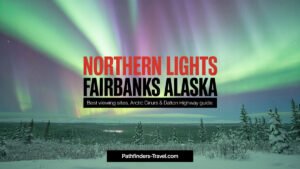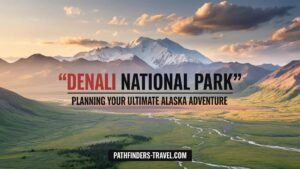Estimated reading time: 17 minutes
Last Modified Date: 09/10/2025
Key Takeaways
- The Kenai Peninsula offers an incredible mix of glacial landscapes, wildlife watching, and outdoor adventures in Alaska.
- Kenai Fjords National Park features the impressive Exit Glacier, the expansive Harding Icefield, and abundant marine wildlife.
- The challenging Harding Icefield Trail rewards hikers with panoramic views of a 700-square-mile ice field.
- Seward serves as the gateway to Kenai Fjords, offering glacier tours and Resurrection Bay kayaking opportunities.
- Homer is known for world-class halibut fishing and access to Kachemak Bay State Park.
Table of Contents
- Introduction
- Seward Spotlight: Gateway to Kenai Fjords National Park and Coastal Alaska Wilderness
- Homer & Its Coastal Charms
- Creating a Multi-Day Itinerary
- Practical Travel Tips and Recommendations
- Frequently Asked Questions about the Kenai Peninsula Itinerary
- Conclusion
Introduction
The Kenai Peninsula stands as a premier adventure destination in Alaska, offering a splendid mix of natural wonders that attract travelers from across the globe. This remarkable region showcases an incredible blend of experiences, from exploring glacial landscapes that have shaped the terrain for millennia to spotting diverse wildlife in their natural habitats. Outdoor enthusiasts find their paradise here with activities like hiking through pristine wilderness and kayaking among floating ice chunks.
This Kenai Fjords National Park guide aims to help travelers discover the many things to do in Seward, Alaska, while also planning adventures to coastal gems like other Alaskan destinations. From glacier viewing to fishing expeditions, the Kenai Peninsula delivers authentic Alaskan experiences that create lasting memories.
Want to discover the Wonders of Alaska in UHD 4K Resolution? Click here to watch the Travel Documentary on YouTube
Seward Spotlight: Gateway to Kenai Fjords National Park and Coastal Alaska Wilderness
The charming coastal town of Seward serves as the key gateway to Alaska’s magnificent Kenai Fjords National Park. This strategic location makes it ideal for exploring marine wonders and taking on ambitious hiking challenges that showcase Alaska’s raw natural beauty.
Kenai Fjords National Park Travel Guide: Exit Glacier, Wildlife, and Glacial Landscapes
Kenai Fjords National Park represents one of Alaska’s most accessible yet wild treasures. At the heart of your visit should be Exit Glacier, the only glacier in the park that you can drive right up to. This accessibility makes it perfect for witnessing the dynamic power of glacial landscapes and observing the natural forest rebirth that occurs as the ice gradually retreats. The marked trail paths allow visitors to safely approach the glacier’s edge and understand its movement through time. Learn more from the National Park Service: Exit Glacier Visitor Guide.
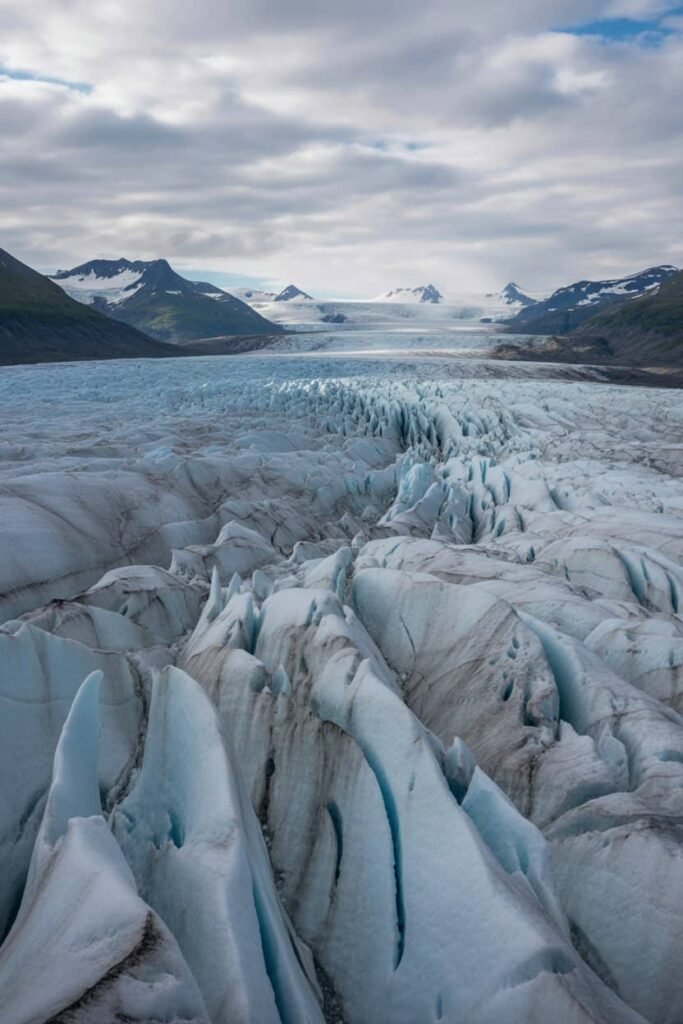
The massive Harding Icefield forms the central feature of the park’s icy topography, covering approximately 700 square miles. According to the NPS Harding Icefield Trail page, this ice sheet feeds nearly 40 glaciers that carve the dramatic fjord landscape that gives the park its name.
Wildlife spotting remains a major highlight for visitors, with chances to see humpback whales, sea lions, and puffins. Learn more about species and viewing tips from Kenai Fjords National Park Wildlife.
Harding Icefield Trail Hike in Seward, Alaska: Route, Difficulty, and Tips
For experienced hikers seeking a challenge, the Harding Icefield Trail delivers both difficulty and extraordinary rewards. This strenuous 8.2-mile round-trip hike includes about 3,300 feet of elevation gain, taking you through several distinct ecological zones. Beginning in a lush forest, the trail gradually climbs above the treeline into alpine meadows before reaching the dramatic viewpoint overlooking the vast icefield.
From the summit, hikers are treated to a surreal panorama that resembles another world – the seemingly endless expanse of ice stretching toward the horizon. Most hikers allow 6-8 hours for the complete round trip, and proper preparation with layers, sturdy footwear, and plenty of water is essential. See full route and trail conditions on the Alaska.org Harding Icefield Trail Guide.
Resurrection Bay Kayaking Adventures: Marine Wildlife and Glacier Views
Resurrection Bay offers some of Alaska’s most accessible yet spectacular kayaking opportunities. Paddlers can navigate through calm, protected waters while gazing up at towering mountains and glaciers. The bay’s crystal-clear waters allow for incredible visibility, making it possible to spot marine life both above and below the surface.
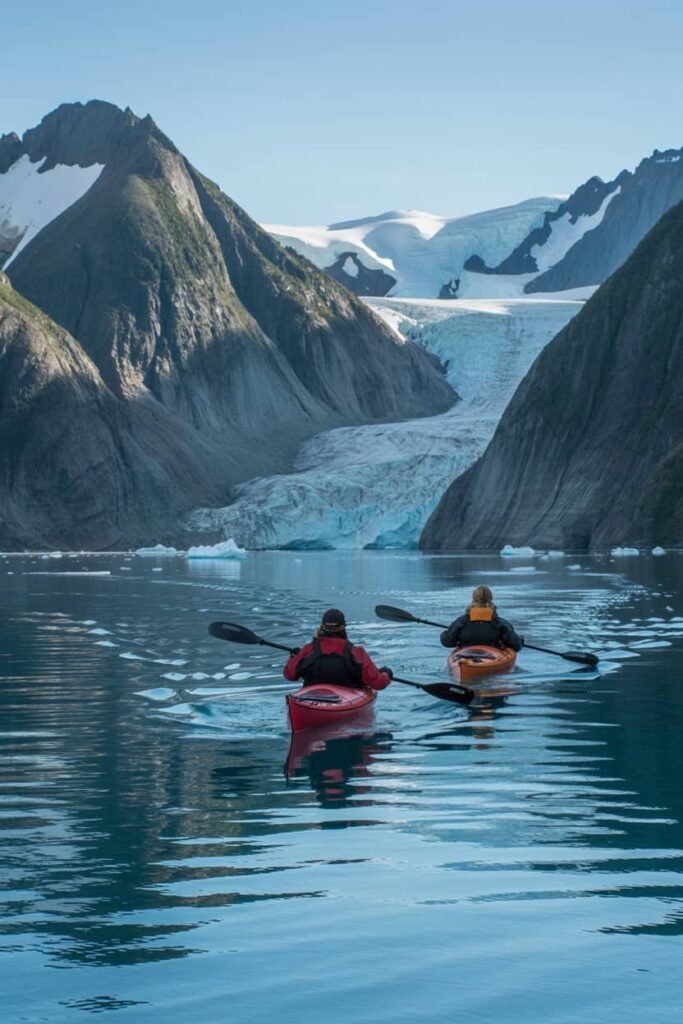
Kayaking tours range from short 3-hour excursions to full-day adventures, with options suitable for both beginners and experienced paddlers. Many tours take you close to tidewater glaciers where you might witness the thunderous spectacle of ice calving into the sea. Wildlife encounters while kayaking commonly include sea otters, harbor seals, and sometimes whales. For guided options, see Northern Latitude Adventures – Seward Kayaking.
Kenai Fjords Tour Tips & Best Season to Visit
When planning your Kenai Fjords adventure, consider booking with trusted providers like Major Marine Tours or Kenai Fjords Tours for glacier and wildlife cruises. These operators offer various trip lengths, from half-day excursions to full-day adventures that venture deeper into the park’s remote areas.
The ideal period to visit falls between late May and early September, when daylight hours are longest and wildlife is most active. This timeframe ensures maximum tour options and generally better weather conditions, though Alaska’s climate can be unpredictable year-round. Many tour operations significantly reduce their schedules or close entirely during the off-season, so Summer visits provide the most comprehensive experience of the park. Reference: Kenai Fjords Tours: Best Time to Visit.
Homer Alaska Travel Guide: Halibut Fishing, Art Scene, and Coastal Adventures
At the southern tip of the Kenai Peninsula lies Homer, a picturesque town with a distinctive artistic flair and rich fishing heritage. Often called the “Halibut Fishing Capital of the World,” Homer balances creative culture with rugged outdoor adventure. The town’s scenic setting, with mountains meeting the sea and the iconic Homer Spit stretching 4.5 miles into Kachemak Bay, creates a stunning backdrop for all activities.
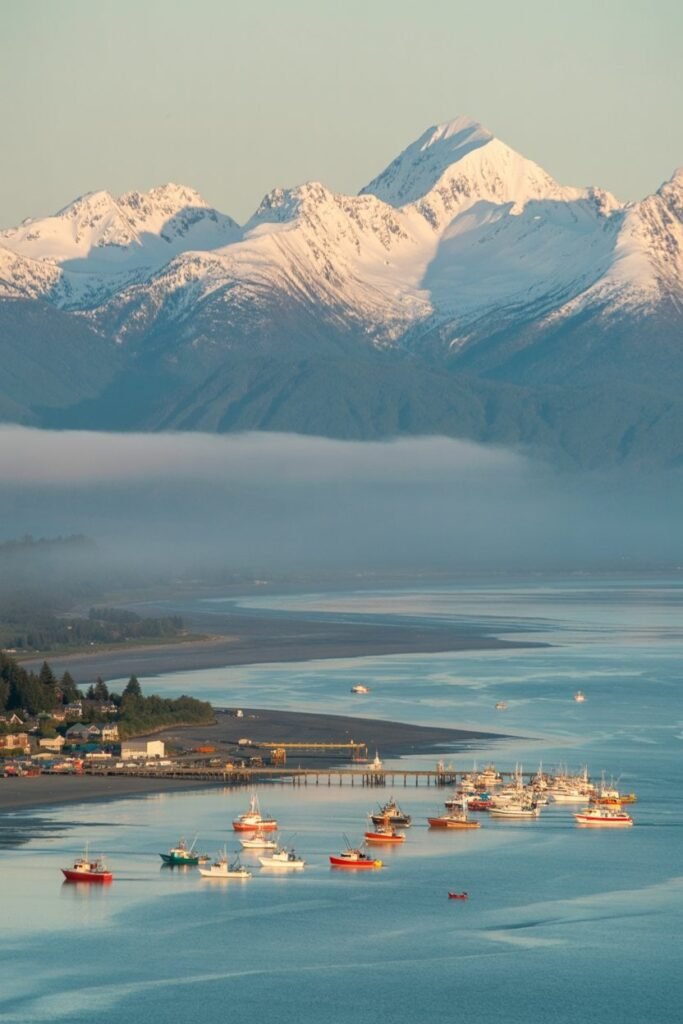
Homer, Alaska, Halibut Fishing
Halibut fishing in Homer represents the ultimate Alaskan angling experience. These massive bottom-dwelling fish can reach several hundred pounds, providing both an exciting challenge and a delicious reward. The peak fishing season runs from late May through September, with July and August typically offering the most consistent catches.
Charter options range from half-day trips to multi-day expeditions, with most boats accommodating 4-6 anglers. Experienced captains know the prime fishing locations and provide all necessary equipment, including rods, reels, and bait. Most charters also offer fish processing services, helping visitors prepare their catch for shipping home. For the best experience, book your fishing charter well in advance, especially if visiting during peak summer months. Details available via Alaska.org Homer Fishing Charters.
Adjacent Adventures
Kenai River Salmon Fishing in Alaska: Species, Seasons, and Best Spots
While Homer has its fishing fame, the nearby Kenai River offers world-class salmon fishing opportunities. This turquoise waterway hosts impressive salmon runs from mid-June to August, with different species arriving in waves throughout the summer. King salmon (Chinook) arrive first, followed by sockeye (red) salmon, then silver (coho) salmon later in the season.
Notable fishing spots include the river sections near Cooper Landing and Soldotna, both accessible within a few hours’ drive from Homer. Guided trips are recommended for newcomers, as local knowledge greatly increases your chances of success on this popular river. Remember that fishing regulations can change year to year, so checking current rules and obtaining proper licenses is essential.
Kachemak Bay State Park Adventures: Hiking, Kayaking, and Glacier Views
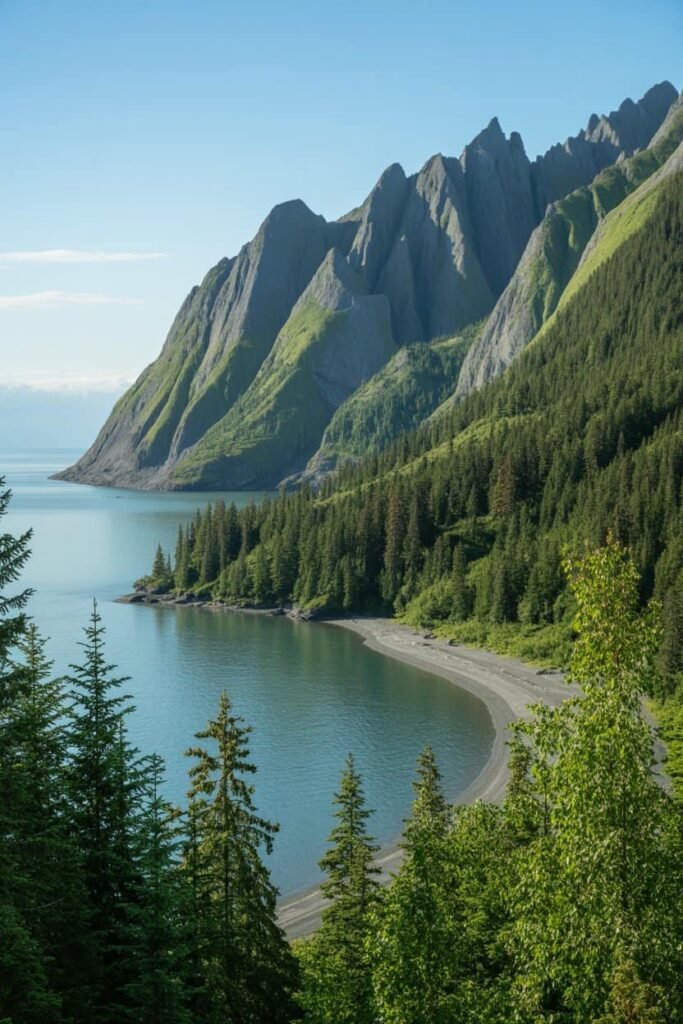
Kachemak Bay State Park offers 400,000 acres of pristine wilderness just a short water taxi ride from Homer. As Alaska’s first state park, it features rugged mountains, lush forests, and secluded beaches accessible only by boat. The park’s network of hiking trails ranges from easy coastal walks to challenging alpine routes.
The popular Grewingk Glacier Trail leads to a glacier-fed lake where hikers can view floating icebergs and the glacier itself. Wildlife watching opportunities abound, with possibilities to spot black bears, mountain goats, sea otters, and bald eagles during your visit. Kayaking along the protected coastline provides another perspective on this remarkable wilderness area, with guided trips available for all skill levels.
Lodging & Dining Recommendations
Homer offers diverse accommodations to suit various preferences and budgets. For waterfront views, consider Land’s End Resort at the tip of the Homer Spit or Ocean Shores with its private beach access. Visitors seeking a more intimate experience might enjoy one of Homer’s many bed and breakfasts, such as Crane’s Rest B&B or Bay Avenue Bed and Breakfast, which often feature stunning views and personalized service.
The town’s dining scene highlights fresh seafood and local ingredients. The Saltry Restaurant on Halibut Cove (accessible by boat) offers a unique dining experience with spectacular views. For casual dining, Fat Olive’s serves excellent wood-fired pizzas and Mediterranean-inspired dishes. The historic Salty Dawg Saloon on the Spit provides both refreshments and local character, with its walls covered in signed dollar bills from visitors worldwide.
Kenai Peninsula Itinerary Planning: Seward to Homer Route and Travel Ideas
Planning a comprehensive journey through the Kenai Peninsula allows you to experience the best of both Seward and Homer, along with the natural wonders between them. Thoughtful planning helps maximize your time in this stunning region, whether you have just a few days or an extended vacation to explore.
Kenai Peninsula Travel Logistics and Driving Route Details
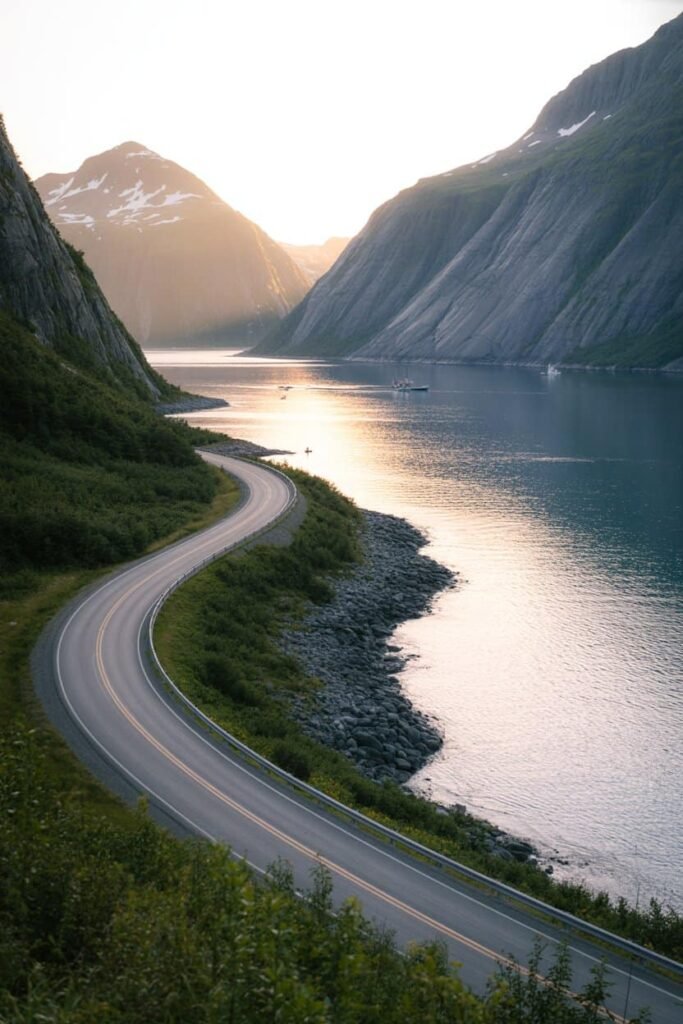
The journey from Seward to Homer covers approximately 170 miles and typically requires 3.5-4 hours of driving time without stops. However, the scenic travel route through Alaska deserves extra time for viewpoints and discoveries along the way. The Seward Highway offers numerous pull-offs where travelers can photograph mountains reflected in lakes, spot wildlife, or simply take in the expansive views.
Consider stopping at the Alaska Wildlife Conservation Center near Portage, where you can observe rescued Alaskan wildlife including bears, moose, and muskoxen in naturalistic settings. The Russian-influenced town of Ninilchik makes another worthwhile detour with its picturesque Russian Orthodox church perched on a hill overlooking Cook Inlet. Learn more at Moon Travel Guides – Southcentral Alaska.
Suggested Kenai Peninsula Itinerary Options (3–10 Days)
3-Day Plan
- Day 1: Arrive in Seward from Anchorage. Spend the afternoon on a wildlife cruise in Kenai Fjords National Park to see glaciers and marine animals.
- Day 2: Morning hike to Exit Glacier or on the Harding Icefield Trail (choose distance based on fitness level). Alternatively, take a guided kayaking tour in Resurrection Bay. Drive to Homer in the afternoon/evening.
- Day 3: Full day in Homer, either on a halibut fishing charter or taking a water taxi to Kachemak Bay State Park for hiking and wildlife viewing.
7-10 Day Plan
- Days 1-3: Explore Seward thoroughly with a full-day wildlife cruise, hiking to Exit Glacier and potentially part of the Harding Icefield Trail, and a half-day kayaking excursion.
- Days 4-5: Drive to the Cooper Landing area for Kenai River activities. Try guided salmon fishing, rafting, or hiking in the Kenai National Wildlife Refuge.
- Days 6-8: Continue to Homer for deep-sea fishing, exploring galleries and shops on the Homer Spit, and taking a full day to visit Kachemak Bay State Park.
- Days 9-10: Optional extension to Soldotna for more fishing or return through Portage Valley with a visit to Portage Glacier and the Alaska Wildlife Conservation Center.
This extended itinerary allows for deeper exploration of each area and builds in flexibility for weather changes or unexpected discoveries.
Kenai Peninsula Travel Planning Tips and Seasonal Advice
The best time to visit the Kenai Peninsula is between mid-June and late August when weather is generally milder and all activities are operating. Early June can still see spring conditions with some trails muddy from snowmelt, while September brings cooler temperatures but also fewer crowds and beautiful fall colors.
If fishing is a priority, research specific salmon run timing: king salmon typically peak in June, sockeye in July, and silver salmon in August. For activities like kayaking, understanding tide tables is essential since low tides can limit access in certain areas.
Permits and licenses require advance planning. Fishing licenses can be purchased online through the Alaska Department of Fish and Game or at sporting goods stores throughout the peninsula. Some trails in Kachemak Bay State Park require parking permits, while backcountry camping in certain areas may need reservations.
Always prepare for Alaska’s rapid weather changes by packing layers, rain gear, and appropriate footwear regardless of forecasts. A sunny morning can quickly become a rainy afternoon, especially in coastal areas.
Practical Kenai Peninsula Travel Tips: Lodging, Gear, and Safety
Making the most of your Kenai Peninsula adventure requires some practical know-how about logistics, accommodations, and safety considerations. These tips will help ensure a smooth and memorable journey through this spectacular region of Alaska.
Booking Tours, Cruises, and Gear Rentals in Seward and Homer
Popular activities like fishing charters, wildlife cruises, and guided kayaking expeditions often fill up weeks or even months in advance during the peak summer season. Book these experiences early, particularly if traveling between June and August or if your dates aren’t flexible. Many tour operators offer online booking with small deposits to secure your spot.
For those interested in self-guided adventures, both Seward and Homer have outfitters providing quality rental gear. In Seward, businesses like Sunny Cove Sea Kayaking and Miller’s Landing offer kayaks, camping equipment, and fishing gear. Homer features similar options with True North Kayak Adventures and Homer Ocean Charters providing rentals along with helpful local advice on conditions and destinations.
When planning your Alaska trip budget, remember that high-quality rain gear rental can save precious luggage space while ensuring you’re prepared for Alaska’s changeable weather.
Where to Stay and Eat on the Kenai Peninsula
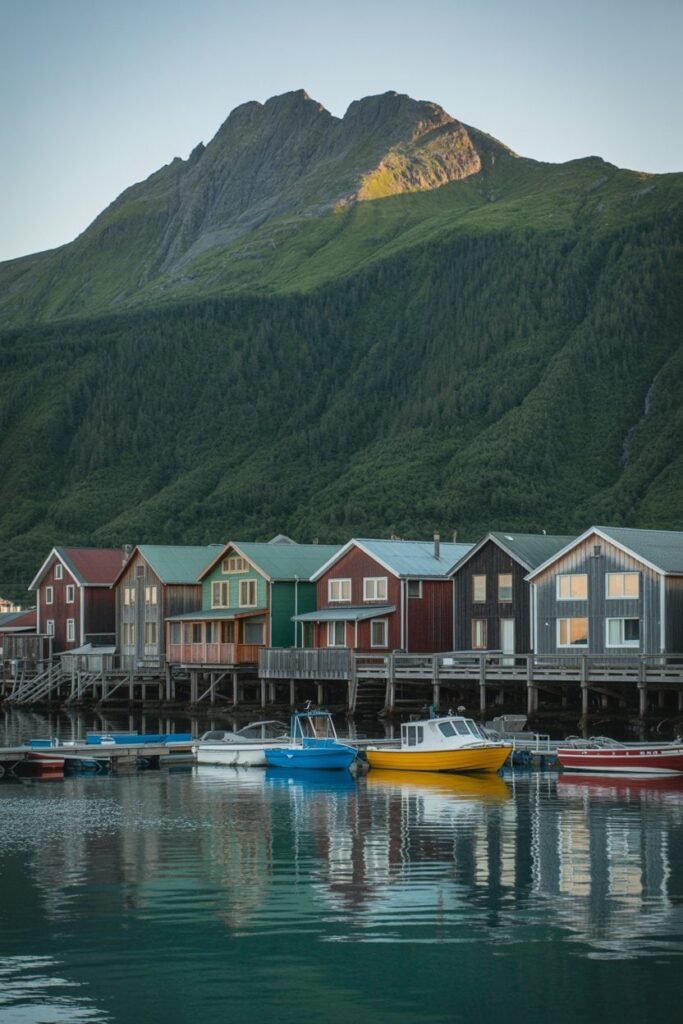
In Seward, waterfront accommodations like Harbor 360 Hotel and Seward Windsong Lodge provide comfortable bases with stunning views. Budget travelers might consider the Moby Dick Hostel or camping at Exit Glacier Campground for a more rustic experience closer to nature.
Seward’s dining highlights include The Cookery for seafood with a modern twist, Thorn’s Showcase Lounge for classic Alaskan fare, and Resurrection Roadhouse for hearty meals after outdoor adventures. For quick bites between activities, Zudy’s Cafe offers excellent sandwiches and coffee.
In Homer, beyond the accommodations mentioned earlier, consider Driftwood Inn for its central location or Beluga Lake Lodge for families needing more space. The Homer Spit Campground puts tent campers right on the beach with million-dollar views.
For memorable dining in Homer, AJ’s Oldtown Steakhouse serves quality meats alongside fresh seafood, while La Baleine Café offers healthy breakfast and lunch options using local ingredients. Don’t miss Two Sisters Bakery for morning pastries and artisan breads that locals line up for.
Kenai Peninsula Safety Tips: Wildlife, Weather, and Navigation
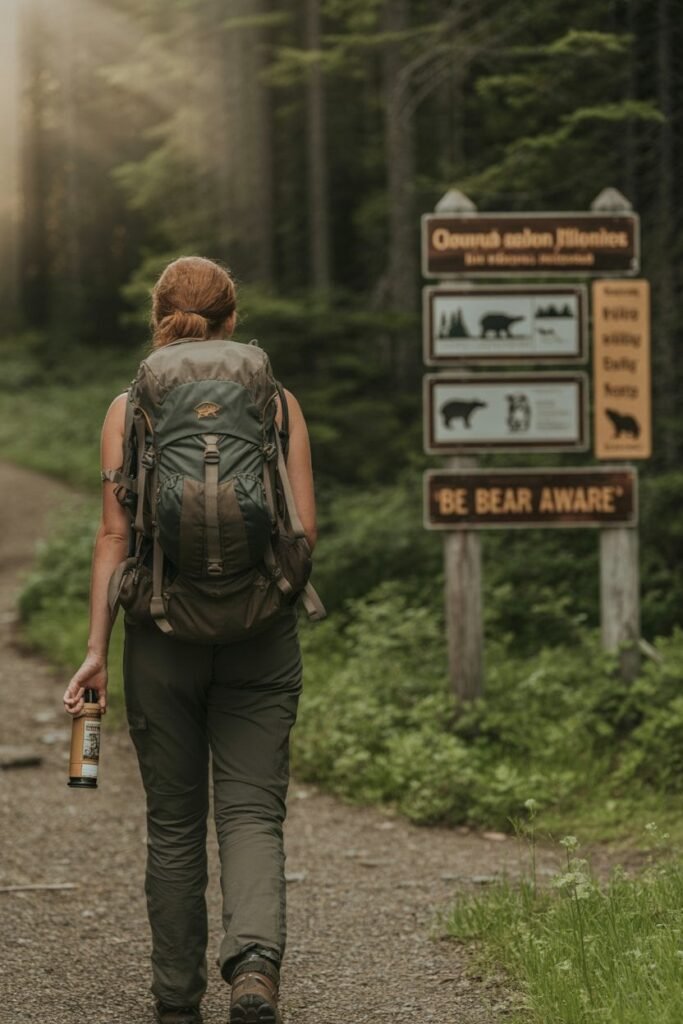
Bear safety should be top of mind when exploring the Kenai Peninsula. Carry bear spray (and know how to use it) when hiking, make noise on trails to avoid surprising wildlife, and properly store food and scented items, whether camping or picnicking. Many visitor centers offer brief bear safety orientations that are worth attending.
Weather preparedness means packing quality rain gear, insulating layers, and sturdy waterproof footwear regardless of forecasts. Conditions can change rapidly, particularly near glaciers and on the water, where temperatures can drop significantly. Hypothermia is a real concern even in the summer months.
Be aware that cell phone coverage remains limited in many parts of the peninsula, particularly in valleys, fjords, and remote hiking areas. Consider renting a satellite phone for backcountry trips, inform someone of your plans when heading out, and bring paper maps as digital navigation may be unavailable.
When boating or kayaking, always check marine forecasts and tide tables. Resurrection Bay and Kachemak Bay can experience significant tidal changes that affect landing spots and currents. Local outfitters can provide the most current information about conditions.
Frequently Asked Questions about the Kenai Peninsula Itinerary
When is the best time to visit the Kenai Peninsula and Kenai Fjords National Park for hiking and wildlife?
The optimal window for hiking, glacier tours, and wildlife viewing is late May through early September, when daylight is longest and tours are most active. Outside this period, some trails, facilities, and services close due to weather or reduced daylight.
How many days do I need to explore the Kenai Peninsula itinerary from Seward to Homer?
A 3-day plan covers major highlights like Seward’s glacier cruise and Homer’s fishing, while a 7–10-day itinerary allows time to explore Seward, Homer, and the Kenai River region in depth — including side trips and rest days for weather flexibility.
What are essential safety and packing tips for exploring the Kenai Peninsula?
This rugged region requires solid preparation. Bring layered waterproof clothing, maps, and bear spray, and always plan for shifting weather. Stay on marked trails, check forecasts, and travel with a partner when venturing into remote areas.
Do I need reservations or permits for Kenai Fjords National Park tours and camping?
There’s no park entry fee, but advance reservations are recommended for glacier cruises, kayaking tours, and public-use cabins, especially in peak summer months. Some campgrounds and backcountry sites operate on a limited-capacity permit system.
How should I plan transport and daily routes for a Kenai Peninsula road trip?
Plan Seward as your starting base for glacier and marine tours, then drive south to Homer along the scenic Seward Highway. Include key stops such as the Alaska Wildlife Conservation Center and Ninilchik, allowing extra time for photography and weather delays.
Conclusion
The Kenai Peninsula is one of Alaska’s most rewarding regions, blending rugged wilderness, thriving marine life, and vibrant coastal towns. From the glaciers of Kenai Fjords National Park to the fishing harbors of Homer, it offers a compact yet comprehensive look at the state’s natural beauty.
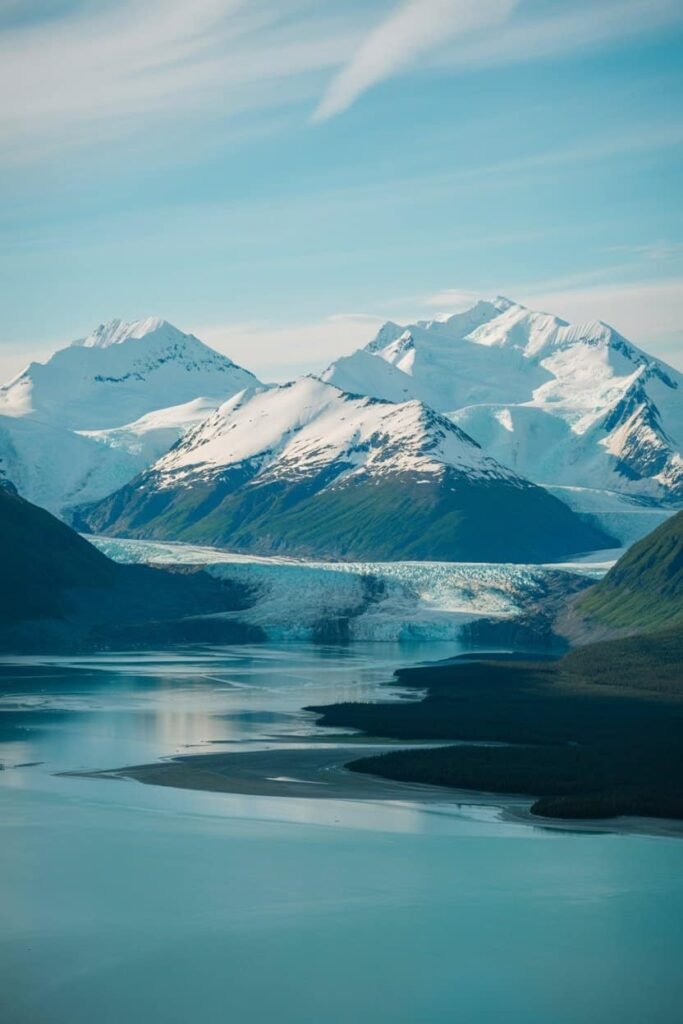
Each journey here can be tailored — whether you prefer long hikes like the Harding Icefield Trail, sea kayaking in Resurrection Bay, or wildlife watching on a glacier cruise. Travelers with more time can link Seward, Homer, and the Kenai River corridor into one seamless adventure.
Its accessibility from Anchorage and range of guided tours make the peninsula ideal for both first-time Alaska visitors and seasoned explorers. By using this Kenai Fjords National Park travel guide, you can design an itinerary that fits your interests while experiencing Alaska’s dramatic coastal landscapes at your own pace.
For those planning a broader Alaska trip, consider reading our related guide on the best day trips from Anchorage to extend your journey beyond the Kenai Peninsula and explore more of the state’s remarkable regions.

